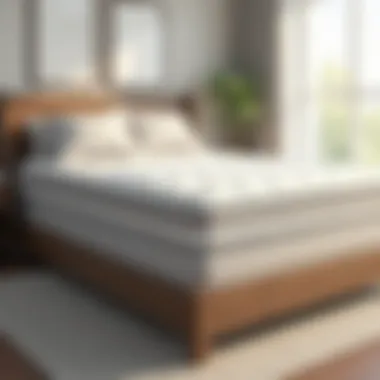The Importance of Box Springs for Your Mattress


Intro
When it comes to creating a sleep sanctuary, the choice of a mattress often takes center stage. However, the relationship between a mattress and the support it rests upon can’t be overlooked. Many people tend to regard a box spring as an optional accessory, a mere bed frame enhancement. Yet, this component serves several key purposes that can shape your sleep quality and the longevity of your mattress. Examining its attributes will reveal whether it deserves a spot in your bedroom—or if alternatives might better suit your needs.
The allure of proper support goes beyond aesthetics. A box spring can play a crucial role in absorbing shock, aligning your body correctly, and even extending the lifespan of your mattress. Each type of mattress—from traditional spring models to the latest memory foam innovations—has its compatibility quirks. In this guide, we’ll break down why understanding these dynamics could be essential to your decision-making process.
Overview of Key Points
In this exploration, we will discuss different aspects of box springs:
- Functionality and benefits of having a box spring.
- Compatibility considerations for varying mattress types.
- Alternatives to box springs and their advantages.
- Practical tips for assessing your mattress and options.
Arming yourself with knowledge about these elements will help you make an informed decision tailored to your specific sleep needs and personal style.
Prelims to Box Springs
Understanding the role of a box spring in your mattress setup is essential for anyone seeking both comfort and longevity in their sleep environment. A box spring serves more than just aesthetic purposes; it plays a significant role in the longevity of your mattress and, by extension, your sleeping experience. In this section, we will explore the fundamental aspects of box springs, delving into their definition and the rich historical context from which they have emerged.
Definition of a Box Spring
A box spring is essentially a sturdy frame that supports a mattress, commonly consisting of a wooden or metal foundation encased in fabric. Its design typically features a set of slats and springs, designed to provide stability and support. Essentially, a box spring helps distribute the weight applied to a mattress evenly, reducing the risk of sagging. This is particularly crucial for innerspring mattresses, which rely on a firm base for optimum performance.
What’s interesting is that while the name "box spring" suggests that springs are the primary element, many modern equivalents come without the springs, relying instead on platforms and other materials for support. Thus, defining a box spring today can also consider the alternatives that fulfill the same role.
Historical Context
The concept of a box spring has deep roots, dating back to the early 20th century. Originally, box springs were designed to enhance the functionality of mattress designs that didn’t yet consider the need for firm support. Early versions utilized actual springs to absorb shock, enabling a mattress to endure more wear over time.
Over the decades, mattresses evolved significantly, branching into various types like memory foam and latex. These innovations raised questions about the necessity of box springs. As home furnishings changed, so did bed designs, leading to alternatives like platform beds and adjustable frames. Interestingly, many antique bed frames were made specifically to accommodate the box spring, showcasing its integral role in traditional bedroom setups.
A box spring, while often overlooked in modern times, carries with it a history of innovation and adaptation that continues to influence how we sleep today.
The Primary Functions of a Box Spring
A box spring is far more than just a decorative addition to your bed; it plays a crucial role in enhancing the overall sleeping experience. Understanding its primary functions sheds light on why pairing a mattress with a box spring can be beneficial. Notably, these functionalities encompass support and stability, shock absorption, and height enhancement.
Support and Stability
When you lay down at the end of a long day, the last thing you want is for your mattress to sag or wobble. A box spring provides a steady, firm foundation that works in tandem with the mattress. This support is vital as it ensures even weight distribution across the mattress surface, preventing dips or uneven areas that can lead to discomfort.
Moreover, most box springs are designed to absorb some movement. This means that if a partner shifts or rolls over in bed, the box spring helps to dampen that motion, resulting in a more restful night's sleep without unnecessary disturbances. Homeowners can appreciate this benefit, particularly if they share their bed with someone who moves frequently throughout the night.
Absorbing Shock


A good night's sleep involves more than just your choice of bedding; it also hinges on the underlying structure. Box springs are engineered to absorb shock, acting as a buffer. Over time, mattresses experience wear and tear due to daily use and pressure. The added layer of a box spring can significantly extend the lifespan of your mattress by taking much of the impact.
Such shock absorption is particularly advantageous for innnerspring mattresses. When you move, sit, or engage in any activity that causes pressure, the box spring alleviates some of that stress from the mattress. This not only reduces potential damage but also keeps your sleeping environment more stable.
Investing in a quality box spring isn't just a luxury; it's a vital step in maintaining your mattress's integrity for the long haul.
Height Enhancement
A box spring naturally elevates the mattress, adding height to the overall bed setup. This added elevation offers several practical advantages. First, it makes getting in and out of bed easier, especially for those with mobility challenges or older adults. A higher mattress can reduce strain on the back and knees during these movements.
Furthermore, aesthetic design plays a role in height enhancement. A well-chosen box spring can elevate the visual appeal of a bedroom, giving it a more polished and upscale look. Whether you lean towards a minimalist style or something more ornate, the box spring height can create a more cohesive design across your space.
Can You Use a Mattress Without a Box Spring?
Choosing whether to utilize a box spring with your mattress is a pivotal decision that directly impacts comfort, support, and longevity. Here, we’ll break down whether it’s feasible to forgo a box spring and what that may entail for your mattress experience.
Compatibility with Different Mattress Types
When considering life without a box spring, the first step is taking stock of the type of mattress in question. Not all mattresses hold the same characteristics, which in turn affects their compatibility with foundations like a box spring.
Memory Foam
Memory foam mattresses are often celebrated for their body-contouring capabilities. They excel in relieving pressure points and providing a sense of weightlessness. One key characteristic of memory foam is its viscoelastic nature, which responds to tempature and weight, thereby molding to the sleeper’s body shape.
This adaptability makes memory foam beds suitable for platform beds or slatted frames, which offer a solid or slightly flexible foundation.
In the scenario where a box spring is skipped, this type of mattress usually fares well, as its structure is intrinsically designed to cradle the body without needing the extra support of a box spring.
Latex
Latex mattresses are another popular choice among sleepers seeking comfort. Known for their durability and responsiveness, latex mattresses can cater to various sleeping positions effectively. One defining feature of latex is its natural elasticity, which lends a buoyant feel.
Choosing to eliminate the box spring can directly affect latex mattresses, but not adversely. In fact, a solid platform or adjustable base can often provide the necessary support while allowing for better airflow, preventing overheating.
Innerspring
Innerspring mattresses, characterized by their coil systems, are a staple in the mattress market. They generally offer a traditional bounce along with varying degrees of firmness. This type of mattress typically relies on a box spring to provide additional support and shock absorption.
Opting not to use a box spring might not be the best choice for innerspring mattresses. When placed directly on a solid base, there’s a risk of the coils losing their efficacy over time, potentially leading to sinkage or sagging.
Ensuring proper support for these mattresses is critical; hence, it's wiser to use them with a box spring or a specifically designed foundation.
Potential Risks of Skipping a Box Spring
While some mattresses can thrive without a box spring, there are undeniable risks involved in bypassing this support system.
- Decreased Lifespan: Not using a box spring, primarily with innerspring mattresses, can lead to quicker wear and tear, ultimately shortening the mattress's lifespan.
- Loss of Warranty: It’s essential to read the warranty fine print. Many mattress warranties specifically stipulate the necessity of a box spring for maintaining eligibility.
- Comfort Issues: Without the added cushioning or shock absorption from a box spring, one might find the mattress can feel firmer, which could lead to discomfort over time.
"Always check the mattress warranty and manufacturer's guidelines first before opting out of a box spring."
In summary, while it is indeed possible to use a mattress without a box spring, the compatibility with various types fundamentally dictates the outcome. Understanding these nuances will not only help in making an informed choice but will also ensure that the investment in a mattress pays off over time.
Alternative Supporting Foundations
When it comes to choosing the right support for your mattress, box springs are not the only option. Various foundations can serve the same purpose as box springs, but they come with their own set of features, benefits, and considerations. In this section, we explore these alternative supporting foundations: platform beds, adjustable bases, and slatted frames. Each has unique attributes that could very well align with your preferences or specific needs.


Platform Beds
Platform beds are a sleek solution that cut out the need for a box spring entirely. Their design features a solid or slatted surface that directly supports the mattress. This type of foundation typically sits closer to the ground compared to traditional setups, which may appeal to those who prefer a lower profile in their bedroom aesthetics.
Benefits of Platform Beds:
- Enhanced Support: Many platform beds offer excellent support for various mattress types, particularly memory foam and latex.
- Under-bed Storage: Their height and design often allow for hidden storage spaces underneath, making them practical for maximizing space.
- Minimalist Appeal: The clean lines of platform beds can match well with modern decor, providing an open and airy feel to a room.
A consideration to keep in mind is that not all platform beds suit every mattress type. For instance, heavy innerspring mattresses may require a sturdier slatted base to prevent sagging over time. Be sure to check compatibility before making a purchase.
Adjustable Bases
Adjustable bases provide versatility that standard box springs simply cannot offer. These foundations allow users to adjust their mattress's position with the push of a button. Whether it’s elevating your head, feet, or both, adjustable bases can enhance comfort while reading or watching television in bed.
Key Aspects of Adjustable Bases:
- Tailored Comfort: Many people find relief from certain ailments—like acid reflux or sleep apnea—by adjusting their sleeping position. It can enhance overall sleep quality.
- Technology Integration: Numerous models come equipped with features like massage settings, USB ports, and even app controls for modern convenience.
- Ease of Access: For the elderly or those with mobility issues, having the ability to adjust the bed height can make getting in and out of bed much easier.
However, keep in mind that some manufacturers do recommend using certain mattress types with adjustable bases for optimal performance. Therefore, if you’re considering this option, ensure your mattress is compatible.
Slatted Frames
Slatted frames are another viable alternative, characterized by a series of wooden or metal slats that support the mattress. This type of foundation can provide flexibility and ventilation, which are crucial for prolonging mattress life.
Why Choose Slatted Frames?
- Airflow: The gaps between the slats allow for better air circulation, helping to reduce moisture buildup and potentially prevent mold growth.
- Affordability: Slatted frames are often more budget-friendly than box springs or platform beds, making them an accessible choice for various consumers.
- Variety of Styles: Available in a broad range of designs and materials, slatted frames can suit various aesthetics, from rustic to contemporary.
Nevertheless, it's important to check the spacing between the slats. Ideally, they should be no more than three inches apart to adequately support the mattress and prevent sagging.
As one can see, while box springs have their place, alternative supporting foundations offer unique benefits that could match your personal lifestyle better. Whether through comfort, aesthetics, or functionality, these options are worth considering as you make your bedding choices.
Evaluating Your Needs
When considering whether to use a box spring with your mattress, evaluating your specific needs becomes paramount. This aspect of the decision-making process isn’t just about personal choice; it carries practical implications that can significantly affect your health, comfort, and even the aesthetics of your bedroom.
Personal Health Considerations
Your health is often the silent partner in sleep—it's crucial, yet easy to overlook. A box spring can offer various health benefits. For instance, individuals with back pain may find that a box spring provides better support to their mattress, facilitating spinal alignment while sleeping. This is particularly true for heavier mattresses, where adequate support is essential to avoid sagging that can lead to discomfort.
Additionally, the shock absorption qualities of a box spring can cushion movements during the night, reducing disturbances. For people with conditions like arthritis or joint pain, this can make a world of difference. Ultimately, prioritizing your health needs while selecting a foundation equips you for better sleep going forward.
Room Aesthetics and Design


Although practicality is critical, the design and feel of your bedroom should not be ignored. The right box spring can elevate the overall appearance of your room. For instance, a tall box spring can create a more luxurious look by raising the mattress higher off the ground, providing a more grand appearance akin to that of a hotel suite. Alternatively, if you lean towards minimalistic decor, a low-profile box spring might be a better fit, streamlining the look of your space.
It’s also important to think about the color and material of the box spring, which should ideally complement your existing furniture. You wouldn't want a vibrant red box spring overshadowing your subtle earth tones, right? Picking the right combination boosts not only your room's visual appeal but also creates a harmonious atmosphere, encouraging relaxation.
Budget Constraints
Finances often play a decisive role in our choices, and purchasing a box spring is no exception. While it might be easy to dismiss the extra expense as unnecessary, the right foundation is an investment in your long-term sleeping comfort. Box springs can vary widely in price, from humble models to luxury versions adorned with features like reinforced frames or plush upholstery.
By assessing how much you’re willing to spend, you can narrow down your options more effectively. A high-quality box spring, while pricier, can lengthen the life of your mattress, preventing wear and tear and potentially saving costs in the long run. It’s always wise to balance immediate needs with future expenses so that you’re not left high and dry.
When evaluating needs, consider your health, aesthetics of your space, and how much you're willing to spend—these factors intertwine to shape your decision.
By delving into these areas—personal health, room aesthetics, and budget constraints—you can make a comprehensive decision that aligns with your lifestyle and sleep needs.
Box Springs and Warranty Implications
When it comes to investing in a good mattress, understanding the warranties that accompany your purchase is paramount. Box springs don’t just function as a base; they play a crucial role in the longevity and durability of your mattress warranty. Often, manufacturers outline specific requirements regarding the type of support a mattress must have, and skipping these recommendations can lead to voided warranties.
Notably, the thoughtful selection of a box spring can not only maintain but also enhance the mattress performance. For instance, if a company states that its product requires a box spring for proper support, ignoring this can be like tossing a life jacket overboard while sailing—it's risky business. Here’s what you should keep in mind:
- Manufacturer Recommendations
Choosing the right box spring means adhering to what mattress manufacturers suggest. They're not just throwing out guidelines for the sake of it. When a manufacturer suggests a specific type or style of box spring, they do so based on extensive testing regarding the durability and comfort of their mattress.
If they specify a platform bed or a particular type of box spring, following that can save you a world of trouble down the line. For example, a brand may directly state that the warranty is void if a certain type of foundation is not used. Not using their recommended box spring, could result in not being able to make a warranty claim if needed.
- Impact on Mattress Lifespan
A box spring bears a part of the weight of the mattress. Its role in shock absorption and distribution directly correlates with how long the mattress will last. Without adequate support, sagging or uneven wear may occur, which could harm the materials used in the mattress, like memory foam or innerspring pockets.
When we talk about lifespan, consider the investment you're making. A quality mattress can cost hundreds, if not thousands, of dollars. Ensuring adequate support from a proper box spring can potentially stretch its life.
"Using the right foundation can prolong the life of your mattress, ensuring you get more bang for your buck!"
In Summary
Both the recommendations from the manufacturer and the implications on the mattress's lifespan emphasize the need for a thoughtful approach to selecting a box spring. Not only does it ensure your mattress maintains its integrity, but it also keeps your warranty intact. When it comes to purchasing a mattress, being diligent about how you set it up goes hand in hand with enjoying it for many years to come.
Closure: Making Informed Decisions
In navigating the space of mattress and box spring relationships, figuring out whether to incorporate a box spring into your sleeping setup can stir up quite the discussion. This article sheds light on the necessity and benefits of a box spring, guiding readers to make choices that are not only practical but also aligning to their sleeping preferences and scenarios.
The flexibility that a box spring can provide is significant. It serves not just as a surface to place your mattress, but as a tool that enhances comfort, support, and longevity. The questions surrounding compatibility with various mattresses, like memory foam or innerspring types, each proffers different considerations that can influence the sleeping experience. Understanding these dynamics is crucial for anyone keen on optimizing their sleep environment.
Key Takeaway: Choosing whether to use a box spring goes beyond aesthetics; it touches on multiple practical benefits that can affect health, comfort, and mattress durability.
Recapping Key Points
As we wrap up this exploration, it’s pertinent to revisit some major talking points:
- Support and Stability: Box springs enhance the overall stability of the mattress. This is especially important for heavier mattress types that can sag without the proper support beneath.
- Shock Absorption: They absorb shock effectively, further protecting the mattress from wear and tear that could potentially shorten its life.
- Compatibility: Different types of mattresses have unique needs. For instance, memory foam may not necessarily require a box spring, while traditional innerspring mattresses typically benefit from one.
- Alternatives: For those who opt not to use a box spring, alternatives like platform beds or adjustable bases are viable options that can also contribute positively to sleeping arrangements.
Final Thoughts
It’s essential to remind oneself that every sleeping scenario is unique. The decision to use a box spring should align with your health considerations, budgetary constraints, and personal style. Details matter, and the bed you sleep on greatly impacts your overall well-being. A poorly supported mattress can lead to discomfort, poor sleep quality, or even permanent physical issues over time.















